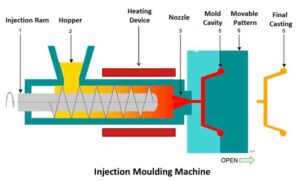Some Known Facts About Manufacturing Industries.s
Wiki Article
Mfg Fundamentals Explained
Table of ContentsAbout Lean ManufacturingAn Unbiased View of Manufacturing IndustriesSome Known Questions About Lean Production.Lean Manufacturing for BeginnersThe Greatest Guide To Additive ManufacturingA Biased View of Lean Production
The message on this page is a sample from our complete White Paper 'Shot Moulding for Buyers' - * Sample message * - for complete overview click the download switch over! Intro This guide is intended for individuals who are wanting to source plastic mouldings. It offers a much needed insight right into all that is involved with producing plastic components, from the mould tool called for to the moulding procedure itself.If you intend to discover better, the overview covers types of mould tools, as well as special completing procedures such as colours & plating. Words that are underscored can be located in the glossary in the appendix ... Part I: Moulding: The Essentials The Advantages of Shot Moulding Plastic shot moulding is a very specific procedure that provides numerous advantages over other plastic processing approaches.
Precision is excellent for extremely detailed parts. You can hold this moulding in the hand of your hand and it has managers, ribs, steel inserts, side cores as well as openings, made with a gliding shut off attribute in the mould tool.
The Single Strategy To Use For Lean Production


from material feed & melting; product injection; cooling down time and ejection to the re-closing of the mould device ready for the following cycle. Draft angles - The wall surfaces of a moulded part must be slightly tapered in the instructions in which the component is ejected from the mould tool, to permit the part to be ejected conveniently.
Ejector stroke - The pushing out of ejector pins to expel the moulded component from the mould tool. Ejector stroke speed, length as well as timing needs to be carefully regulated to protect against damage to the ejectors and mould tool, but at the very same time make the moulding cycle as short as possible.

Unknown Facts About Oem
Ribs - find here When a plastic part has slim wall surfaces, ribs are contributed to the style to make the thin walls stronger Side cores - Side activity which creates a feature on a moulded component, at an opposing angle to the typical opening instructions of the mould tool. lean manufacturing. The side core needs to be able to withdraw as the plastic component can not be ejected or else.
Wall surfaces - The sides of a moulded part The text on this web page is a sample from our full White Paper 'Shot Moulding for Purchasers'.
Manufacturing process for generating components by injecting liquified material right into a mould, or mold Simplified layout of the procedure Injection moulding (united state spelling: shot molding) is a manufacturing process for generating components by injecting liquified product into a mould, or mold and mildew. Injection moulding can be performed with a host of materials primarily including steels (for which the procedure is called die-casting), glasses, elastomers, confections, and the majority of generally polycarbonate and thermosetting polymers. Shot moulding is extensively used for making a selection of parts, from the tiniest elements to entire body panels of autos. Injection moulding makes use of a special-purpose machine that has three components: the shot device, the mould as well as the clamp.
Facts About Oem Uncovered
, with the quantity used of the previous being considerably higher.: 13 Thermoplastics are widespread due to attributes that make them highly ideal for injection moulding, such as convenience of recycling, adaptability for a wide selection of applications,: 89 and capability to soften and move on heating.In numerous tooth cavity moulds, each cavity can be similar and develop the very same parts or can be one-of-a-kind as well as create multiple various geometries during a single cycle. Moulds are usually made from tool steels, but stainless-steels and aluminium moulds appropriate for sure applications. Aluminium moulds are commonly ill-suited for high volume manufacturing or get rid of narrow dimensional resistances, as they have substandard mechanical buildings and are much more vulnerable to wear, damage, as well as contortion throughout the click over here now shot as well useful link as securing cycles; nevertheless, aluminium moulds are cost-effective in low-volume applications, as mould manufacture costs as well as time are substantially reduced.
When enough material has gathered, the product is compelled at high stress and also rate right into the component creating dental caries. The exact amount of shrinking is a function of the resin being used, and can be reasonably foreseeable. To stop spikes in stress, the process typically uses a transfer position representing a 9598% complete tooth cavity where the screw shifts from a consistent rate to a continuous pressure control.
The 9-Second Trick For Manufacturing Industries
When the screw gets to the transfer position the packing stress is used, which completes mould filling as well as makes up for thermal shrinking, which is rather high for thermoplastics relative to numerous other products. The packaging stress is used until eviction (dental caries entryway) solidifies. As a result of its small size, the entrance is generally the starting point to solidify with its whole thickness.: 16 Once the gateway strengthens, no even more product can enter the cavity; appropriately, the screw reciprocates as well as obtains product for the following cycle while the material within the mould cools so that it can be ejected as well as be dimensionally steady.Report this wiki page